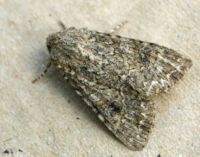- Nutmeg (moth)
-
Nutmeg moth 
Larva of Hadula trifolii Scientific classification Kingdom: Animalia Phylum: Arthropoda Class: Insecta Order: Lepidoptera Family: Noctuidae Genus: Hadula Species: H. trifolii Binomial name Hadula trifolii
Hufnagel, 1766Synonyms - Discestra trifolii
- Anarta trifolii
The nutmeg (Anarta trifolii or Hadula trifolii), also known as the clover cutworm, is a moth of the family Noctuidae. It is found throughout Europe although in the north of its range it is a summer migrant, not being able to survive the cold winters.
This is a small to medium (wingspan 33-39 mm) species with cryptically coloured forewings, varying from light to dark brown, sometimes with a reddish tinge. The most characteristic feature is a distinctively "W"-shaped, white subterminal line. This feature is seen on some other noctuids, but usually much larger species. The hindwings are grey or buff, darker towards the termen, and marked with dark veins. One or two broods are produced each year, and adults can be seen at any time from May to September. This species flies at night and is attracted to light as well as to sugar and nectar-rich flowers.
Flight from June to first half of July. Second generation from latter half of July to September.[1][clarification needed]
The larvae feed on a wide range of plants (see list below). The species overwinters as pupae.
Recorded food plants
- Allium
- Amaranthus - amaranth
- Apium - celery
- Arachis - peanut
- Asparagus - asparagus
- Atriplex
- Beta - beet
- Brassica
- Cannabis
- Chenopodium - goosefoot
- Cytisus - broom
- Glycine - soybean
- Gossypium - cotton plant
- Halogeton
- Hibiscus
- Lactuca - lettuce
- Linum - Flax
- Lycopersicon - tomato
- Medicago - alfalfa
- Nicotiana - tobacco
- Petroselinum - parsley
- Phaseolus - common bean
- Pisum
- Populus - poplar
- Portulaca - purslane
- Raphanus - radish
- Rheum - rhubarb
- Ricinus - castor bean
- Salsola
- Scorzonera
- Sonchus - sow-thistle
- Spinacia - spinach
- Taraxacum - dandelion
- Trifolium - clover
- Ulmus - elm
References
Reading
- Chinery, Michael Collins Guide to the Insects of Britain and Western Europe 1986 (Reprinted 1991)
- Skinner, Bernard Colour Identification Guide to Moths of the British Isles 1984
Categories:- Hadeninae
- Animals described in 1766
Wikimedia Foundation. 2010.

